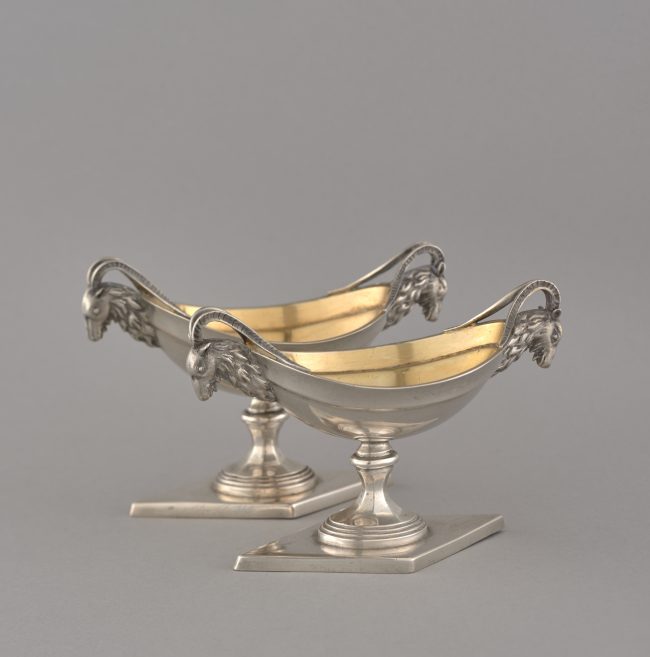
Pair of salt cellars
The set of salt cellars in the form of bowls imposed on low stems originates from the workshop of Tomasz Klimaszewski. The presented model, named with reference to its vessel-like shape, was manufactured in many silver-smithing centres. It also enjoyed high popularity with Warsaw manufacturers whose offer included a range of its variations – from simple and formally restrained salt cellars from the turn of the 19th century, to highly decorative artefacts with stems in the shapes of a dolphin or a seahorse from the second quarter of the same century.
The presented salt cellars originate from the second decade of the 19th century, a period when Warsaw gold-smithing and silver-smithing witnessed the decline of Neoclassical purism, which yielded place to Empire trends. Those tendencies originated from France and became widespread in Europe during the rule of Napoleon Bonaparte (1769–1821, Emperor of the French 1804–1814, 1815). Their handles in the shape of goat’s head as well as shiny smooth curves of the vessel-shaped bowl and profiled stem already represent an Empire aesthetics. In Warsaw, that style functioned until the mid-1830s. Craftsmen adorned their silver items with lyres, dolphins, ram and goat heads, lion paws, goat hooves, putti, ancient heroes and deities. Such decorations adopted the form of plaquettes or solid stems and handles. Sculptural elements were contrasted with polished silver surfaces.
Tomasz Klimaszewski, the maker of the salt shakers, was active in Warsaw from the 1800s until the end of the 1830s. In the initial period, his objects of everyday use were devoid of decoration and featured simplified austere forms. With the advent of the Empire fashion, his workshop began to produce items which followed that style. Regardless of the adopted convention, Klimaszewski’s works are distinguished by their shapely and balanced proportions, consistency and noble forms. Those features bear testimony to the considerable talent of the maker.
The rules of etiquette required salt cellars to be situated close to each place setting. Moreover, attention was paid to symmetrical arrangement. Therefore, salt cellars were often sold in pairs, while large sets comprised as many as twelve pieces. Small scoops were usually added to take salt from the container. Their bowls and the interiors of salt cellars were usually covered with gold. Thus, a reaction was prevented between salt and copper, which was added in small quantities to silver. Copper had a hardening effect on silver, yet in contact with salt it unfortunately produced verdigris – a greenish compound which is detrimental to health. Therefore, gilding had a protective function, but at the same time it increased the aesthetic and material value of the items.
Pair of salt cellars
TOMASZ KLIMASZEWSKI WORKSHOP
WARSAW; C. 1815
GILDED, CHASED, CAST SILVER
MHW 17373/1–2
SALT CELLAR 1: 8 × 11,8 × 5,5 CM
SALT CELLAR 2: 7,6 × 11,7 × 5,3 CM
Image licensed under: ![]()
